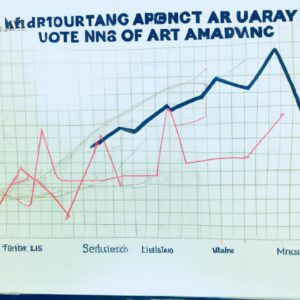AR Is Revolutionizing Manufacturing Processes
Augmented reality (AR) is changing the way manufacturers are able to approach their processes. By overlaying digital information on the physical world, businesses can use AR to optimize their production process.
Using AR in manufacturing can bring many benefits, from cost savings to improved safety. This technology is also becoming increasingly necessary as businesses adjust to new realities caused by the COVID-19 pandemic. In this guide, we’ll explore how AR is helping to streamline manufacturing processes and why it matters.
What is Augmented Reality (AR) and How is it Helping to Streamline Manufacturing Processes?
Augmented reality (AR) is a technology that allows virtual elements to be added to a real-world environment. It has been used in both entertainment and industrial settings, but recently, it has seen an increase in use in manufacturing processes. The reason for this is because AR can provide significant advantages over traditional means of production, such as cost savings, improved efficiency, improved safety and more.
AR is being used by many companies in the manufacturing industry to increase their productivity and reduce their costs. By using AR, manufacturers are able to reduce errors, improve quality control, and streamline their production processes.
One of the primary benefits of using AR in manufacturing is that it eliminates the need for human labor. AR technology can be used to perform tasks that were previously done by workers, such as inspecting parts or assembling components. This leads to increased accuracy and speed of production, as well as improved safety since employees are no longer required to carry out potentially hazardous tasks.
Another key benefit of AR is its ability to provide manufacturers with better visibility of their production line. With AR, manufacturers are able to monitor the progress of their production from start to finish, allowing them to spot and address any issues quickly. This ultimately leads to increased efficiency and cost savings.
Finally, AR technology is becoming increasingly popular due to its potential for creating new ways of doing things. For example, AR can be used to create 3D simulations of products and processes, which can help manufacturers to troubleshoot and optimize their production. Additionally, AR can be used to provide interactive visual aids to help workers to learn how to complete tasks more efficiently.
Benefits of Using Augmented Reality in Manufacturing
Augmented reality (AR) is a technology that allows users to combine both physical and virtual worlds together, enabling them to interact with objects as if they are actually present. AR has already become a popular tool for many industries, including manufacturing, where it is used to optimize processes throughout the entire production process.
The benefits of using AR in manufacturing are numerous. The first advantage is cost-savings. By introducing AR into the manufacturing process, companies can reduce costs associated with training employees on new production techniques, as well as the cost associated with equipment and materials. Additionally, AR can help to streamline production lines, reducing the amount of time spent on each task and allowing for faster production times.
AR is also beneficial in terms of safety. By using the technology, workers can be better protected from hazardous conditions in the workplace. For example, AR can provide workers with better visualization of potential hazards, allowing them to take necessary safety precautions before undertaking tasks.
AR also provides improved efficiency and accuracy. With the use of AR, companies can not only reduce errors in the production process, but also help to ensure that products are of the highest quality. Additionally, AR can help boost productivity by providing workers with the ability to visualize tasks and processes in real-time.
Finally, AR can provide a more immersive experience for both workers and customers. AR can enable customers to view products in their own environment, as if they were actually present, and can give employees the chance to interact with products and processes in a more engaging way.
Challenges with Implementing AR
AR technology is still relatively new, and many companies may be concerned about the cost and effort associated with implementing it. There are several potential challenges to keep in mind when considering the adoption of Augmented Reality in manufacturing.
First, there are technological limitations that must be addressed. AR technology requires the use of sophisticated hardware and software, and this can be expensive and may require significant time and resources to set up. Furthermore, it’s possible that existing systems may need to be upgraded or replaced in order to accommodate AR.
Additionally, employee resistance to change is a common challenge when introducing new technologies in any industry. Introducing AR into manufacturing processes will require employees to learn how to use the new technology, which could be a difficult process for some. There may also be budget constraints to consider when implementing AR in manufacturing, as companies may need to allocate additional funds for training and support.
Finally, the legal implications of using AR technology must be taken into account. As with any new technology, there may be privacy and data protection concerns that need to be addressed prior to implementation.
Overall, the challenges associated with introducing AR into manufacturing processes must be acknowledged and addressed before a successful implementation can take place.
Examples of Companies Utilizing AR
Augmented Reality (AR) is revolutionizing the way manufacturing processes are being conducted. Companies are increasingly utilizing this technology to streamline, speed up and automate production cycles, leading to greater efficiency, safety, and cost savings. Let’s take a look at some of the companies that have successfully implemented AR into their manufacturing processes.
One noteworthy example is Volkswagen AG, a German automaker. Volkswagen has incorporated AR into its assembly lines, providing workers with real-time information on assembly steps while allowing them to control the manual processes. This has resulted in improved accuracy and a reduction in errors. Overall, the incorporation of AR has led to improved quality and safety standards, as well as higher productivity levels.
DHL Express is another major company that has turned to AR for its manufacturing needs. The company has implemented an AR-based warehouse system which allows workers to easily locate items within the facility. This system was designed to reduce the amount of time spent looking for items, resulting in employees being able to pick orders more quickly and accurately. Additionally, the system has helped DHL to reduce errors and maintain customer satisfaction.
Toyota Motor Corporation, one of the world’s largest automakers, has also utilized AR to improve its manufacturing processes. Recently, Toyota has implemented an AR-based system which uses cameras and sensors to help workers in the assembly areas. This system provides workers with real-time feedback on tasks, allowing them to quickly identify problems and take the necessary steps to resolve them.
These are just a few examples of the many companies that are reaping the benefits of AR in manufacturing. With more companies investing in this technology, it is likely that we will see even more applications in the near future.
Future Outlook and Possibilities
Augmented Reality (AR) has already begun to revolutionize the manufacturing industry and its potential is only beginning to be explored. As AR technology continues to advance, there are a number of exciting possibilities in store for the future. Manufacturers can look forward to better training methods, improved safety, and greater efficiency.
The introduction of wearable technology has allowed for enhanced training opportunities. By taking advantage of interactive 3D displays on augmented reality glasses, workers can obtain hands-on experience in a simulated environment without the need for physical equipment. This technology also has the potential to help workers gain a more in-depth understanding of more complex machinery or systems.
AR has also been proven to reduce safety risks in the workplace. The ability for employees to visualize the inner workings of machines has dramatically reduced the chances of workers making costly mistakes. Its use also eliminates the need for dangerous manual labor, such as climbing ladders or working with hazardous materials.
Finally, AR can streamline processes and allow manufacturers to achieve greater levels of efficiency and cost savings. Visual guidance systems can provide employees with step-by-step instructions for assembling components or executing tasks, thus reducing the amount of time it takes to complete a job. AR can also help to reduce waste by ensuring that materials used in the manufacturing process are used correctly and efficiently.
The possibilities for AR within the manufacturing industry are truly limitless, and the technology is only getting better. It is clear that AR will continue to have a profound impact on the industry, transforming the way that manufacturers operate and paving the way for a more efficient and cost-effective future.
Augmented Reality Helping to Streamline Manufacturing Processes
Augmented reality (AR) is quickly becoming a powerful tool in the manufacturing industry, allowing for efficient streamlining of processes, cost savings, and other advantages. In this guide, we’ll explore the basics of AR, its role in manufacturing, the benefits and challenges associated with it, and examples of how successful companies are utilizing it.
Definition of AR and Its Role in Manufacturing
Augmented reality can be defined as a technology that combines real-world environments with virtual reality elements. It is most commonly used in entertainment and gaming, but its uses are beginning to expand into fields like manufacturing. In this context, augmented reality can be used to create detailed 3D visualizations of components and products, as well as providing real-time feedback on the production process.
The use of augmented reality in manufacturing is becoming increasingly popular due to its ability to improve quality control, reduce costs, and decrease time spent on complex tasks. Additionally, AR can be used to provide remote assistance, which can be especially helpful for large manufacturing plants. Overall, AR is an incredibly versatile tool that can be used in many different areas of the manufacturing industry.
Benefits of Using Augmented Reality in Manufacturing
One of the biggest benefits of AR in manufacturing is cost savings. The use of AR can reduce costs by eliminating the need for manual labor and improving the efficiency of the production process. Additionally, AR can help to improve quality control, as the 3D visuals can be used to identify potential defects quickly and easily. This can result in fewer defective products and decrease overhead costs associated with returns and repairs.
Another major benefit of using AR in manufacturing is increased safety. By using AR, workers can avoid dangerous tasks, such as working with hazardous materials. Furthermore, AR can improve worker accuracy, as task instructions can be provided in real time to minimize errors and decrease the risk of injury.
Furthermore, augmented reality can improve employee satisfaction, as they will be able to work more efficiently and effectively. Lastly, AR can improve customer satisfaction by reducing the time it takes to produce and ship products, resulting in faster delivery times.
Challenges with Implementing AR
Though there are many benefits of using augmented reality in manufacturing, there are a few challenges associated with it as well. One of the main issues is technological limitations. AR requires specialized hardware and software, which may not be available to all manufacturers. Additionally, the cost of implementing AR can be prohibitive for some manufacturers, particularly those with tight budgets.
Another issue is employee resistance. Many employees may be uncomfortable with the idea of AR being utilized in their workplace, and may be reluctant to embrace the new technology. Finally, there is a lack of knowledge and expertise in the field of AR, which can make implementation difficult.
Examples of Companies Utilizing AR
A number of companies have successfully implemented AR for their manufacturing processes. For example, Boeing has used AR to speed up the production of aircraft components and increase accuracy. Additionally, Audi has used the technology to help its assembly line workers visualize vehicle parts, which has reduced errors and improved production efficiency. Lastly, Honda has adopted AR to help technicians repair and maintain its vehicles.
Future Outlook and Possibilities
The use of augmented reality in manufacturing has only just begun, and the possibilities for the future are endless. One exciting possibility is the use of AI to create intelligent systems that can recognize objects in real time, and offer guidance on how to best utilize AR for a specific task. Beyond that, more innovative uses of AR in manufacturing will surely emerge in the years to come.
Conclusion
Augmented reality is quickly becoming a powerful tool for the manufacturing industry, offering numerous advantages over traditional methods. AR can improve the efficiency and accuracy of the production process, reduce costs, and help to improve safety. Additionally, AR can provide remote assistance and help to make employees’ jobs easier. Ultimately, the use of AR in manufacturing is only going to continue to grow, and the possibilities for the future are exciting.
comments: 0











